Raspberry bushes are amazingly resilient and produce some of my favorite fruits. Even so, I wondered what kinds of protection my raspberry plants need during the winter months – if any at all.
To protect raspberry plants during the winter, select only hardy plants appropriate for the zone. Then, depending on the winter weather, raspberry bushes may also need to be pruned, cut back, mulched, protected from wind, or completely covered. This will prevent dieback and protect fruit production.
Ready to learn how to protect your raspberry plants during the winter? Keep reading to see what I’ve learned in both my research and experience with raspberries!
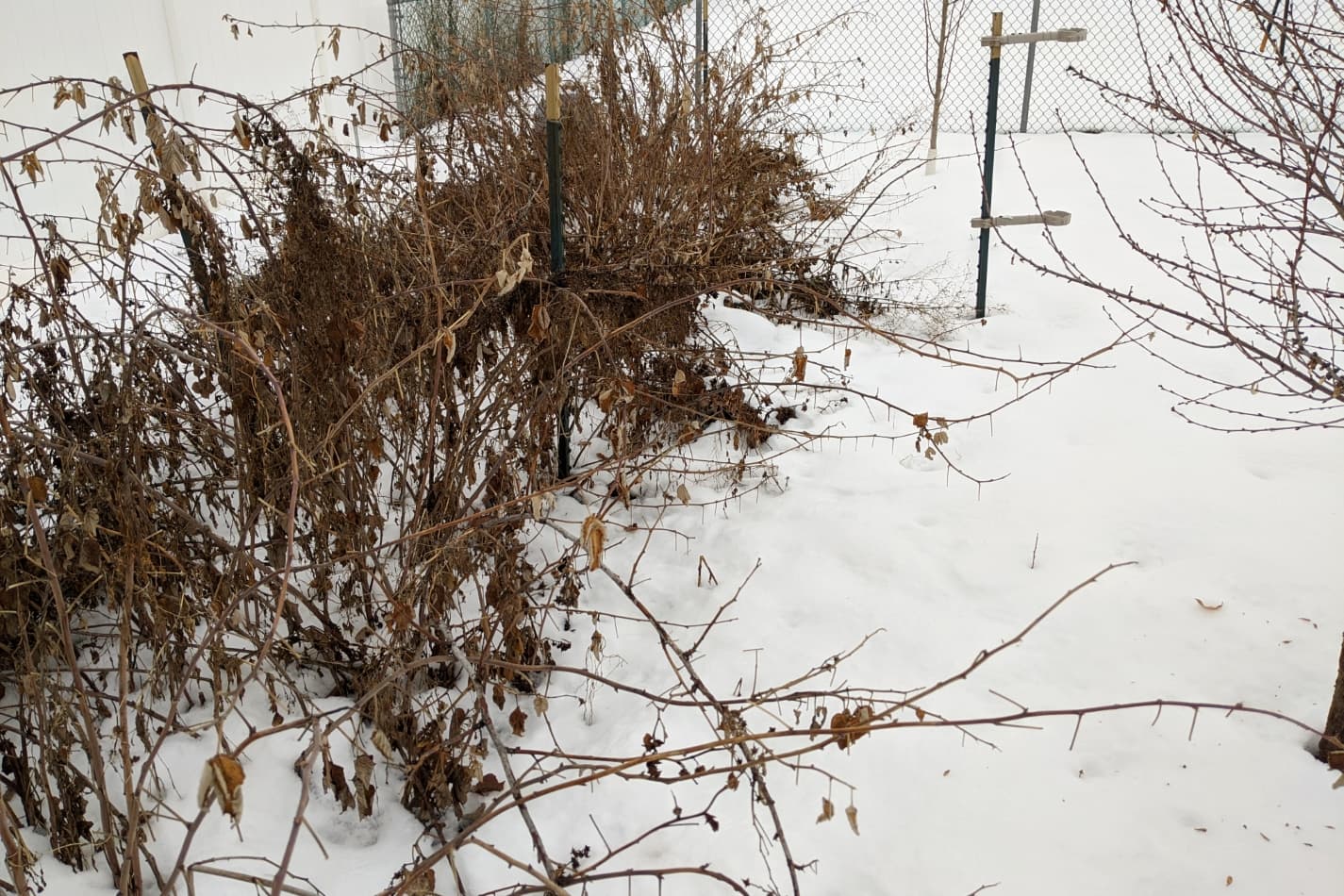
Step-by-Step Guide to Protect Raspberry Plants in Winter
As you’re getting ready for winter, you’re going to need to protect your raspberry plants. And, in order to make that easier, I’ve created a step-by-step guide or system, based on what I do every year.
Okay, so some of these steps are going to be a one-off kind of thing – like planting the right variety of raspberry or determining which variety you have. That step won’t need to be done every year – unless you keep forgetting what variety you have. So in that case, it might be wise to write it down in your gardening journal or spreadsheet.
Even so, here are all of the steps to follow in order to protect your raspberry plants each winter.
| Step-by-Step Guide | Rationale and Notes |
|---|---|
| Select and plant zone-appropriate raspberry bushes. | 1. Find your zone. Then, pick a raspberry variety that will do well in your zone. Most garden websites and online nurseries will let you search based on your zone. Or, for in-person help, talk to a local nursery or garden master. 2. If you already have raspberries, determine what type they are by watching them over the course of a year or more. |
| Determine which canes produce the fruit: the primocane or floricane. | This really only needs to be done once. Just make sure you know the type – or write it down for later. Knowing which cane grows and bears fruit will affect how and when you prune your plants. Don’t worry – we’ll talk about when to do that later on in the article. |
| Water your raspberry plants until the first frost. | This makes sure that your plants will have enough water reserve to be more resilient throughout the winter – and avoid dehydration damage – despite the cold and snow! |
| Remove sick, diseased, or canes with parasites. | Do this any time they’re noticed, though, and not just at designated pruning times. This will protect the plants and help them stay resilient, which will further protect the bushes during the winter season. |
| Remove canes growing outside the designated row. | This can be done any time unless you’re wanting to transplant that raspberry to another area. In that case, you’ll want to dig up the starts in the late spring for a transplant. |
| Inspect your trellis system. | If you choose to use a trellis, be sure to inspect it each spring and fall. That way, you can set it up to help protect your raspberry bushes each winter by using it as a visual guide to where they’re at. |
| Protect raspberries from winter winds. | Strong and cold winter winds can increase winter damage through desiccation. You can protect them with windbreaks (like a fence) or by covering them. |
| Mulch and/or cover your raspberries for the winter if needed. | Depending on your area, mulching the raspberry plants at their base may be sufficient. For colder or more severe winters, you also may want to completely cover the raspberry canes that will bear next year’s fruit. |
| *Prune your raspberries. | The timing and severity of pruning your raspberry plants will depend on the variety, cane type, and personal preference. So we’ll cover this in more detail in another table and section of the article. |
| Top raspberry canes if desired. | If you prefer shorter raspberry bushes (that may not need a trellis system), cut off the tops of the raspberry canes at an even, regular height so they get plenty of sunlight and airflow. Topped canes will grow less fruit – but the berries will grow quite large. |
The pruning of your raspberry plants is going to have some variation to it. And that’s okay. It’s going to depend on which type of raspberries you’re growing and your personal preference.
In my research, I’ve discovered that when you prune your raspberries is quite the gardening hot topic – it’s almost funny how passionate various people get about when to prune berry bushes. In either case, one camp is strong of the opinion that “it’s got to be done in the fall!” The other camp swears that the only appropriate time to prune raspberries is in the spring.
Based on my experience, though, it’s easiest for me to prune fall-bearing raspberries in the fall – and easiest to prune summer-bearing varieties in the spring.
Want more info on pruning raspberries by variety? Read my article Pruning Raspberries: The Complete Guide.
| Care and Pruning Tips | Summer-Bearing Raspberries (Floricanes) | Fall-Bearing Raspberries (Primocanes) |
|---|---|---|
| Which canes produce fruit | Canes that grew last year (also known as 2nd-year canes or floricanes). | Canes that grew this year (also known as 1st-year canes or primocanes). |
| Remove canes that are sick, diseased, or have parasites | Any time (to improve overall health and resilience). | Any time (to improve overall health and resilience). |
| When to prune the canes | Remove or prune floricanes after the harvest. | You could cut down all the canes at the end of the harvest. |
| After-harvest pruning: fall or next spring? | Either is fine (I prefer the following spring). | Either is fine, though I think fall is better for winter protection. |
| Why I prefer that season | Leaving the pruning till spring means more foliage, free compost, and more winter protection. | After the harvest, mow the canes down and lay down a layer of mulch. That way, it’s protected for winter and ready for spring growth. |
| Winter Protection | Mulch the raspberries, tie canes to the trellis and cover them if needed to protect them from wind and/or snow. | Mow the canes down in fall and cover the raspberry patch with a layer of mulch for full winter protection. |
In other words, I’m all about what’s efficient, easy, and effective. So do what makes sense for you – but now you know which I prefer and why. These days, I only have summer-bearing varieties, though, so all of my raspberry cane pruning is now in the spring.
Speaking of waiting until spring to prune, though, here’s how my raspberries look in the winter. They’re going to need some serious attention during the spring. But that’s okay. Because they’re protected for the winter.

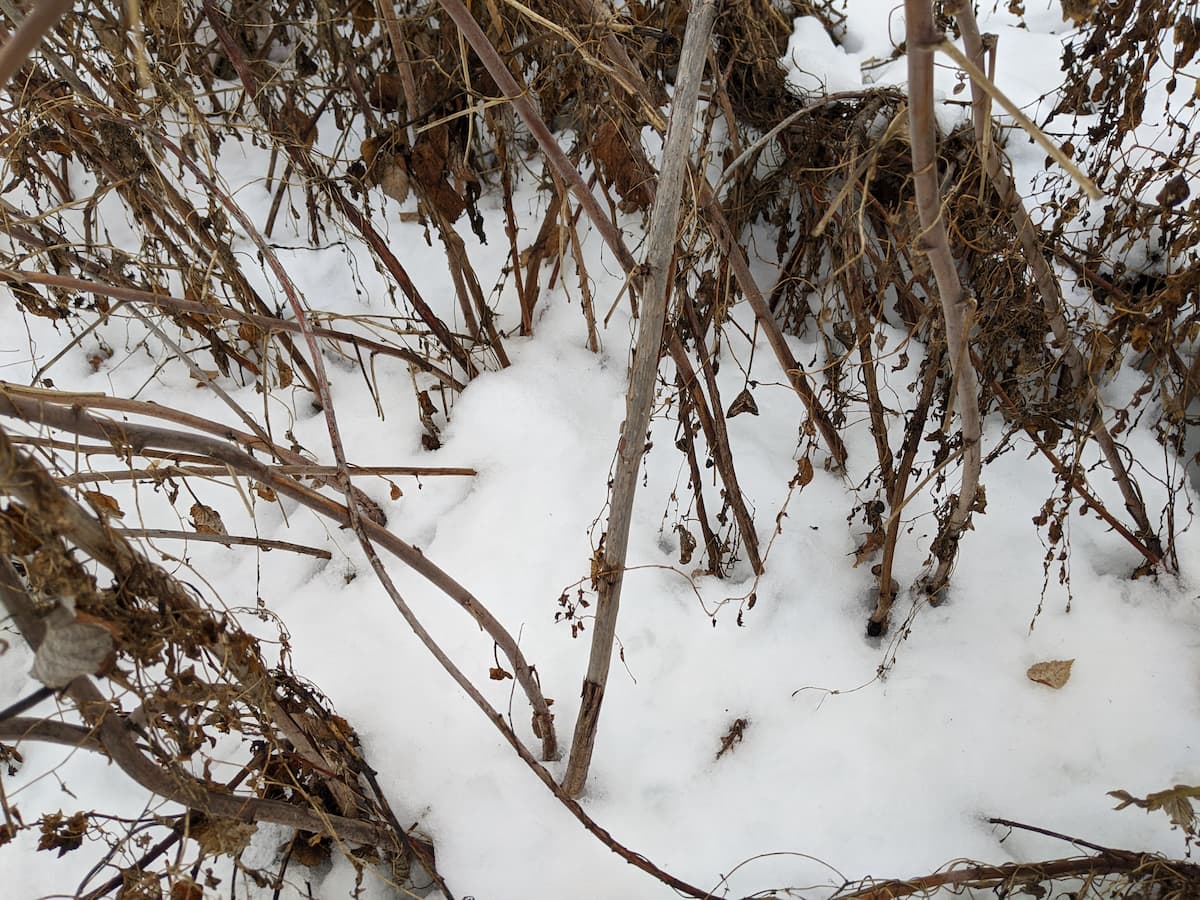
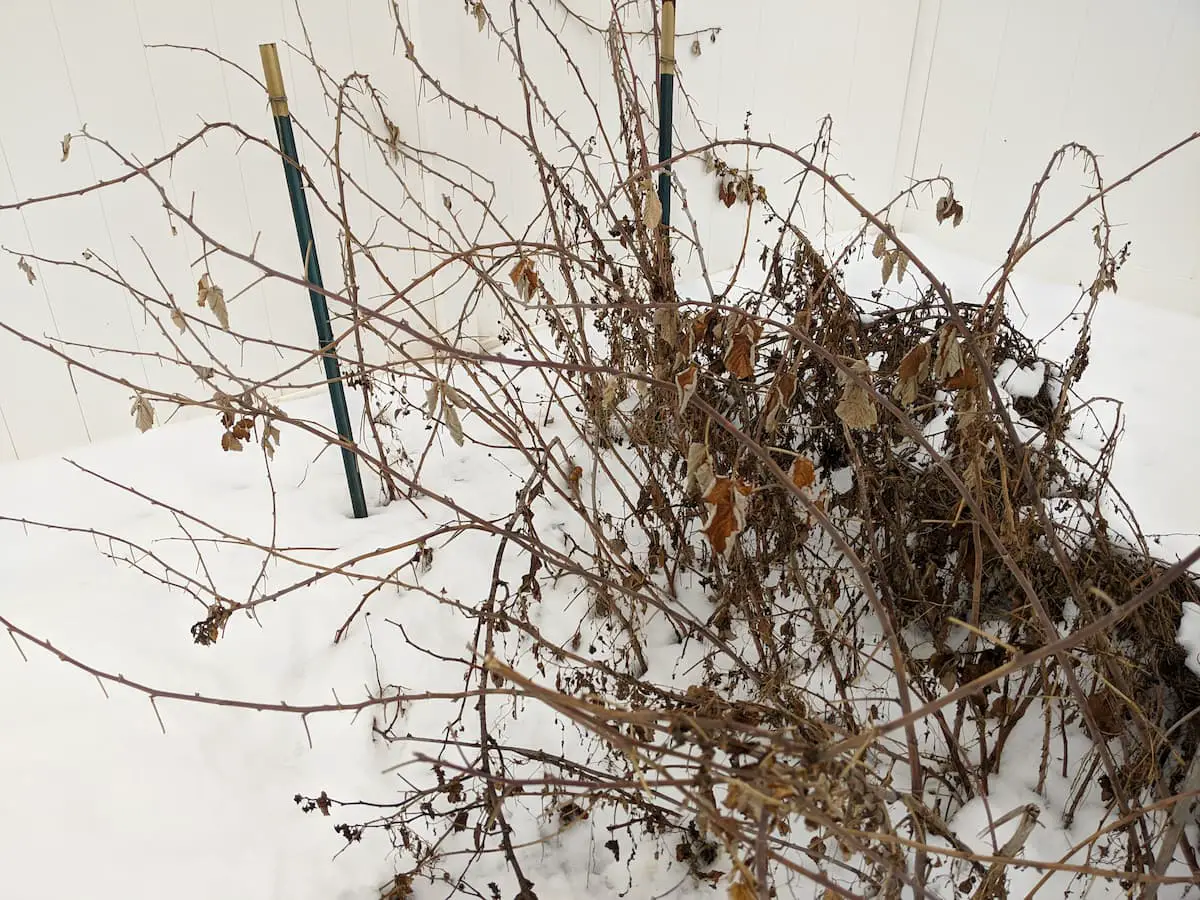
Now, where we’re at in Utah we don’t get a ton of winter snow. Maybe a foot or two during our snowiest times. The real issue here is the winter winds from the canyons. Those can get to hurricane speeds – and are what cause the most winter damage.
For that, our raspberries are planted at the back corner of our lot – where they’re protected on two sides by fences. One fence is along the western-ish side of the berry patch, while the other is on the southern-ish side. On the eastern-ish side, we’ve got fruit trees and (further on) another fence. So we’ve got all sorts of windbreaks to protect the berries (and the fruit trees).
By using the foliage, a layer of mulch, a fence as a windbreak, and then the snow itself to insulate my plants? They do fairly well during the winters.
Just for comparison’s sake, here are the raspberry plants after the snow has melted – and the pruning process is well underway. The weeding isn’t completely finished – but it’s started and a great comparison to the above photographs.
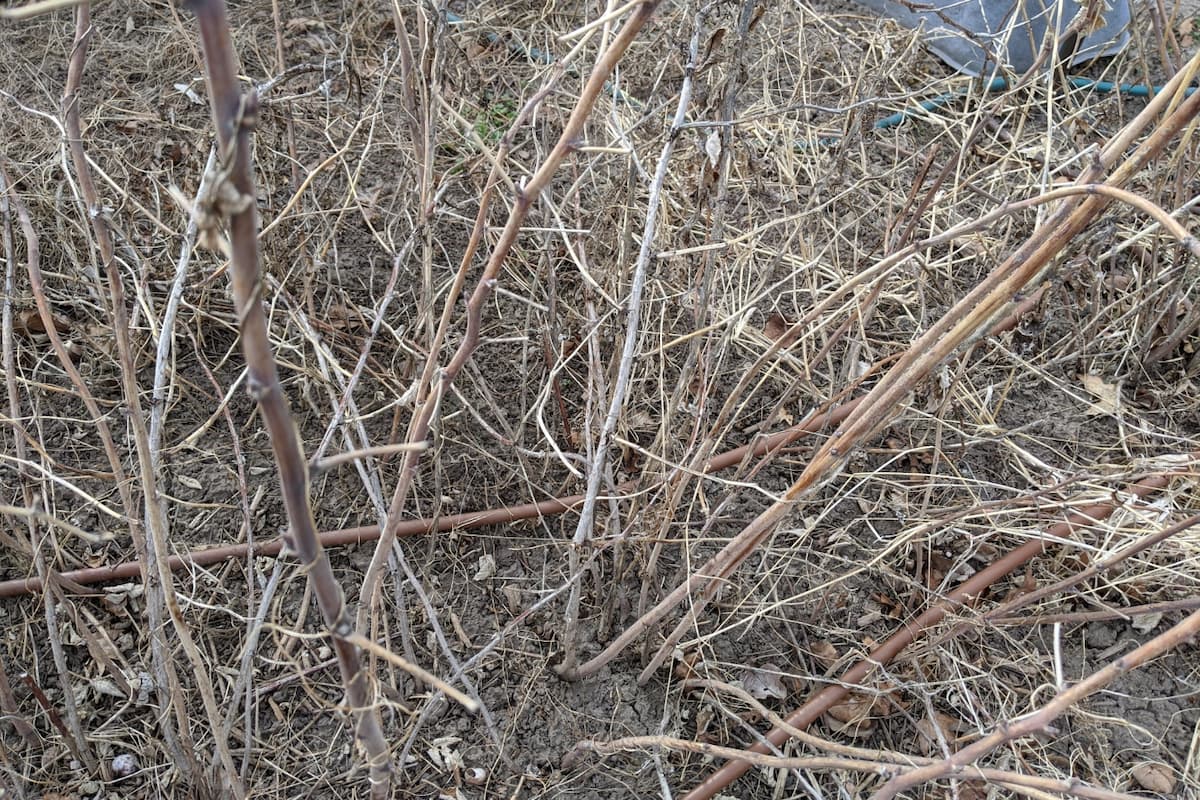
It’s still too early for the foliage to start growing, which is good – I’ve got more time to thin the plants and keep working on the trellis.
Notes on Protecting Summer-Bearing Raspberries from the Winter
Summer-bearing raspberries are delicious (okay, all raspberries are delicious!). I’m partial to this variety because it’s been working so well for our backyard homestead. Even so, let’s make sure they stay safe during the winter.
The most important thing to remember with summer-bearing raspberry plants during the winter is that you do need to protect the canes that just grew that year. The canes that just grew are first-year canes – but they’re next summer’s two-year-old, fruit-bearing canes.
If next year’s fruit-bearing canes get damaged? That will have a big impact on your raspberry crop come summertime.
Thankfully, you’ve got a few options – some of which were already mentioned, like pruning and general care for your berry bushes.
When you do your pruning of summer-bearing raspberry plants, you’ll also want to thin your plants back – to no more than 4-6 canes per foot of row. That way, your plants will get plenty of sunlight and airflow to help your bushes grow the best possible crop.
You can do this in either the fall or the spring, depending on your preference. Like I said earlier, each one has its supporters, evidence, and rationales as to why it’s the best option. And, depending on how you do either option, it could be better for you.
So let’s go through each process. If it’s your first year growing raspberries, try the fall pruning process first – with a heavy-duty spring inspection of your raspberry plants. That way, you’ll get a good idea of how to care for your raspberry plants.
Fall Pruning Steps for Best Winter Protection
(Summer-Bearing Raspberries)
- Remove foliage and debris, including any weeds.
- Remove spent floricanes (those that bore fruit this past harvest) at ground level.
- Remove canes growing outside the designated rows. Thin the remaining canes to a maximum of 4-6 canes per foot.
- If desired, top the raspberry canes.
- If you prefer tied canes, tie the remaining canes to your trellis for next spring. This step could be done in early spring instead if desired.
- Put down a layer of fall mulch at the base of the canes to protect them for the winter.
- If winters in your area are harsher, consider additional winter protection, like bending canes down and completely covering them with a light layer of mulch or dirt.
- In the spring, remove any dirt or mulch covering the canes. Make sure the canes are on the trellis (resting or tied). Do any other clean-up to prepare the bushes for summer.
Once you’ve at least tried the fall pruning, then you can test switching to spring pruning to see if that jives better with your gardening methods and timing.
Spring Pruning Steps for Best Winter Protection
(Summer-Bearing Raspberries)
- After the harvest, you may want to add some fall mulch or compost to the raspberry patch. Then, be sure your raspberry plants have some measure of winter and winter wind protection.
- Remove foliage and debris, including any weeds.
- Remove canes growing outside the designated rows. Thin the remaining canes to a maximum of 4-6 canes per foot.
- If desired, top the raspberry canes.
- If you prefer tied canes, tie the remaining canes to your trellis.
- If you want or need to, put down a layer of spring mulch or compost at the base of the canes to improve soil quality and plant growth.
- Get ready for the summer harvest.
Personally, I prefer removing spent canes in the spring. I like using those spent canes as insulation during the winter. However, I do also like to use fall mulch to protect the next year’s canes. And I also regularly evaluate my raspberry plants to make sure that my process continues to work. If I ever do find that it’s not adequate winter protection for my raspberry bushes, I’ll change my systems to get better results.
Notes on Protecting Fall-Bearing Raspberries during the Winter
The most important thing to remember with fall-bearing raspberry plants during the winter is this:
- A summer crop will grow on last year’s canes.
- A fall crop of raspberries grows on the canes that grew that year.
Fall-bearing raspberries are delicious, too. If you want fall-bearing raspberries – and are happy with a single crop? Then fall-bearing raspberries are amazingly easy to prepare for winter.
A big benefit of fall-bearing raspberries is that you can cut down all the canes each fall after the harvest. Cover the area with a layer of mulch – and your raspberries are protected for the winter.
Fall Pruning Steps for Best Winter Protection of Single-Crop Systems
(Fall-Bearing Raspberries)
- After the harvest, mow down the remaining raspberry canes. You can quite literally use your lawnmower, provided it’s beefy enough to handle the raspberry canes.
- Lay down a layer of mulch to protect your canes for the winter – and provide soil enrichment for spring growth.
- In the spring, check the soil and watch the raspberry canes grow.
However, if you want to turn your fall-bearing raspberries into a two-crop system (getting fresh raspberries during summer – and again in the fall), then you will need to do a little bit more work. And the plants will need some more winter preparation, too.
To get a two-crop system going with your fall-bearing raspberries, you’re going to need to protect any canes that grew that summer for the next year as well as prepare the soil for new canes to grow next spring and summer.
Pruning Steps for Best Winter Protection of Double-Crop Systems
(Fall-Bearing Raspberries)
- After the harvest, you may want to add some fall mulch or compost to the raspberry patch. Then, be sure your raspberry plants have some measure of winter and winter wind protection.
- Then follow the pruning steps for either fall or spring pruning of the spent canes. Either option can be fine and is based on your personal preference, your area, and other factors as indicated in the above section of this article.
- Remove spent floricanes (those that bore fruit for the two previous years) at ground level.
If you do opt for a two-crop system for your fall-bearing raspberries, remember that both crops will likely be a smaller yield – after all, you’re getting in two crops! Based on my research, the double crop is smaller than if you did a single, fall harvest each year.
How to Winterize and Protect Potted Raspberry Plants
Not everyone grows their raspberries in the ground as we do – so what should you do if your raspberry plants are being grown in a pot? Well, you’ll need to do some extra work to protect those potted raspberry bushes during the winter.
First, you’ll need to protect the whole pot from freezing, depending on how your winters are. You can do this one of several ways, while still following the recommendations above for pruning your potted raspberry plant based on its variety.
- Wrap the potted plant in an insulating material and put it somewhere protected, safe, and warm. For some plants and locations, this might just mean moving the potted plant to your porch.
- Dig a hole in your yard and bury the pot. Don’t bury it so deep that you can’t get it back out again in the spring, though! But bury it enough that the dirt in the pot is level with the ground. That way, your potted plant will get some natural insulation and protection from the winter cold. Then, you may still want to use mulch or wraps to protect the raspberry canes, depending on if it’s summer or fall-bearing raspberry plant.
- Bring your potted plant into a protected and warmer environment. This could be inside the house, a greenhouse, or another room that has a steady temperature all winter. Due to temperature fluctuations, the garage should be the last option considered. If you do keep your potted plants in the garage, they may experience stunted growth and fruit production the following year.
I’ve tried storing potted blueberry plants in the garage – it doesn’t work well. So if you’re going to bring the pot inside, make sure it’s in an area that has a fairly steady temperature. And even then, you may still want to wrap the pot in some sort of insulating material.
That poor blueberry plant never did well in a pot, though. And while I haven’t ever kept raspberry plants in pots, I’m inclined to believe that they do better in the ground than they do in pots. So if you can transplant that potted raspberry plant to the ground, consider doing so!
Having an in-ground raspberry patch has been one of my favorite parts of our backyard homestead!
Do Raspberries Lose their Leaves in the Winter?
Raspberries aren’t evergreen plants. They most definitely lose their leaves as soon as it gets too cold! And then they’ll look like long, ugly sticks.
Compare the two pictures of my raspberry plants in summer and winter.
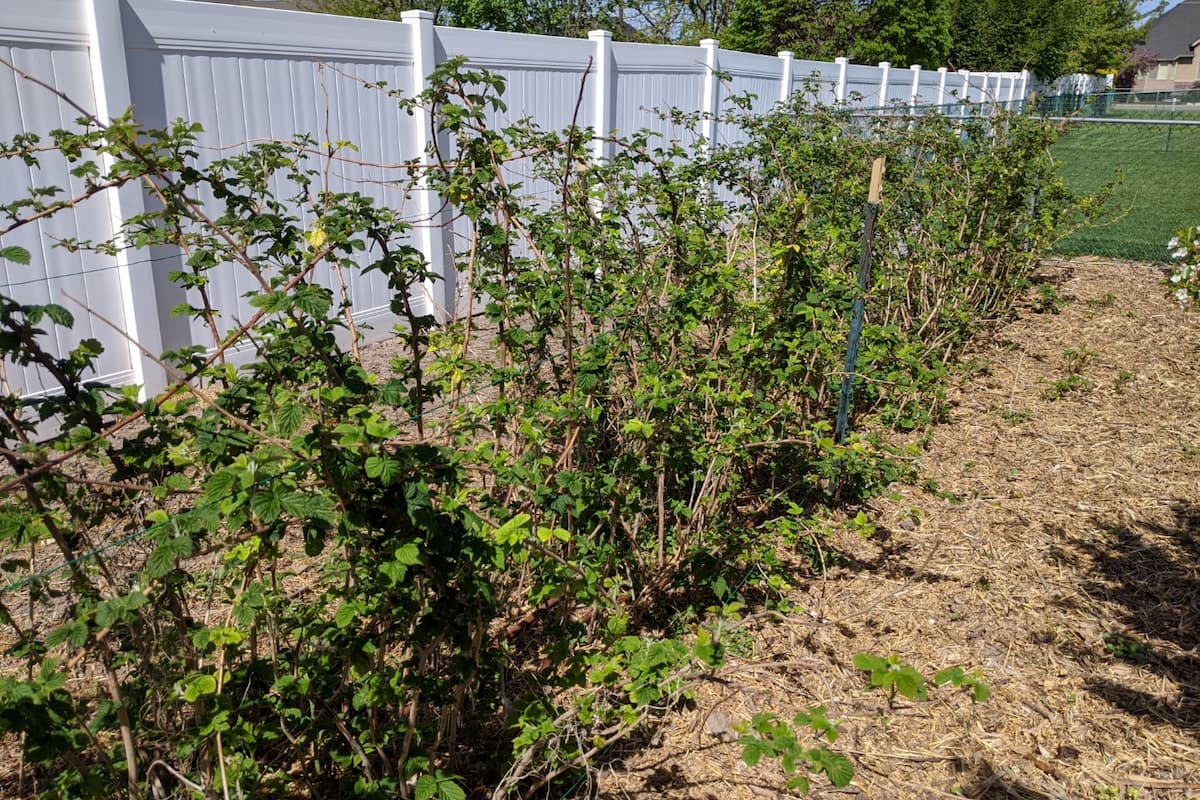

During the summer they’re green, leafy, and alive. During the winter they look quite dead – even though many of those canes are simply hibernating.
Oh, and many of the leaves you do see in that wintertime picture? Yeah, there are a lot of dead weeds in that picture. Once it starts getting chillier, I stop stressing about weeds growing in the raspberry patch (as long as they don’t go to seed). I see that extra vegetation as winter insulation. It all gets pulled and cleared in the spring.
What Winter Damage to Raspberries Looks Like
Winter damage to a raspberry plant looks like this: a cane that grows some fruit and leaves up to a certain point – but beyond that point, it’s just a stick. That whole cane may also have far less fruit and foliage than it would have had without winter damage.
This kind of winter damage has the very self-explanatory term of being called partial die-back.
Other types of winter damage can include desiccation (plant dehydration and death), wind damage, and plant sunburn. These kinds of damage usually result in partial or full die-back of the canes and decrease fruit production by a significant amount – if not completely eliminate fruit production on the affected canes.
Protect Raspberries from Pests and Insects Year-Round
One final tip about winter protection of your raspberry plants… keep pests to a minimum year-round. Doing so will mean that your plants are healthier, more resilient, and better able to survive the winter.
In other words, if you can protect your raspberries from pests (and bugs) during the whole year, then your plants will have a better reserve to fight off winter damage and dieback during the cold months.
Related Questions
What Happens if You Don’t Prune Raspberries? Raspberries that aren’t pruned will still grow. However, as the canes will get significantly less light and airflow, the amount of fruit will be much less. Due to the increased canes, it will also be harder to harvest the fruit. What Happens If You Don’t Prune Raspberries? What To Expect!
When Should Raspberries Be Cut Back? Raspberries can be cut back at the end of the harvest if they’re fall-bearing primocanes or summer-bearing floricanes. Cutting back other canes may affect your next year’s harvest.
What Happens if Raspberry Canes are Too Tall? Too-tall raspberry canes will lean over once leaves and fruit grow. This can make getting to the fruit harder unless you use a trellis system for tall canes or top the canes.
Can Raspberry Bushes Grow in the Shade? Raspberry bushes can grow in the shade, although they do need full sun for maximum berry production. Read more about shade, sun, and raspberries in my article here.
Resources
Learning from your own experience is essential, but learning from others is also intelligent. These are the sources used in this article and our research to be more informed as homesteaders.
- Maughan, Tiffany, and Brent Black. “Raspberry Management for Utah.” Horticulture Utah State University Extension, Apr. 2015, https://digitalcommons.usu.edu/cgi/viewcontent.cgi?article=1700&context=extension_curall.
